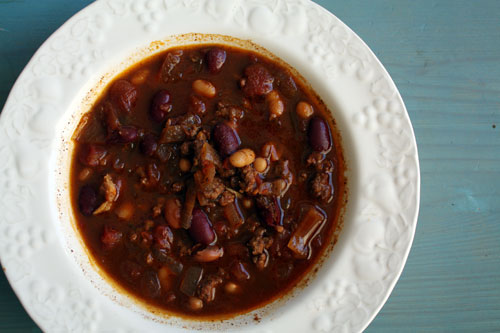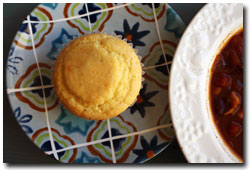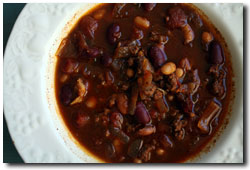
Recently I started digging deeper into the history of chili. I wanted to use our new Dutch oven that we received as a wedding gift last year to make a rich soup for fall. Immediately I thought of chili. But then what recipe to make? As I began searching through my many cookbooks and online resources, I was surprised to learn of just how many variations there are of the dish. Hundreds!
 Chili seems to have originated in the southwestern United States, specifically along the “Texas Trail” back in the days of cowboys and cattle drives across the western U.S. I say “seems” because no one really knows when the first bowl of chili was actually served. And although the recipe can vary, it usually consists of a few basic ingredients: meat (although there are now vegetarian versions as well), beans, peppers and spices with no ingredient dominating the mix, but rather creating a blend of flavors.
Chili seems to have originated in the southwestern United States, specifically along the “Texas Trail” back in the days of cowboys and cattle drives across the western U.S. I say “seems” because no one really knows when the first bowl of chili was actually served. And although the recipe can vary, it usually consists of a few basic ingredients: meat (although there are now vegetarian versions as well), beans, peppers and spices with no ingredient dominating the mix, but rather creating a blend of flavors.
To get the full scoop on chili, I consulted the experts at the International Chili Society (ICS), whose members are proudly known as “chiliheads”. The ICS is a non-profit organization that sanctions chili cook-offs with judging and cooking rules & regulations. These events are worldwide and benefit charities or non-profit organizations.
All winners of ICS sanctioned cook-offs qualify to compete for cash prizes and awards at the World’s Championship Chili Cook-off held each year in October. The ICS is the largest food contest, festival organization in the world. This year’s championship event took place just a few weeks ago in Charleston, West Virginia. The ICS houses a wealth of information about chili and its history on their website at www.chilicookoff.com. They also offer on their website some winning recipes in the three cook-off categories, Red, Green and Salsa. According to the ICS here are the facts when it comes to chili’s past:
Fact: Chile peppers were used in Cervantes’s Spain and show up in great ancient cuisines of China, India, Indonesia, Italy, the Caribbean, France, and the Arab states.
Fact: Don Juan de Onate entered what is now New Mexico in 1598 and brought with him the green chile pepper. It has grown there for the nearly four hundred years since.
Fact: Canary Islanders, transplanted in San Antonio as early as 1723, used local peppers, wild onions, garlic, and other spices to concoct pungent meat dishes – improvising upon ones they had cooked for generations in their native land, where the chile pepper also grew.
Everything after that gets a little fuzzy. If you ask a Texan, they will tell you that the dish originated in their state, and there seems to be a lot of evidence to support that claim. In late 19th-century San Antonio, “Chili Queens” dished out the concoction in the town square, substituting expensive chocolate and cinnamon found in mole with readily available chile peppers and meat. However, purists there will tell you that the dish is made of meat and chile, no beans.
Chili recipes can be altered to fit your taste buds. A perfect example of a new twist on an old favorite is the very different Cincinnati version of the dish, which is served over spaghetti noodles, has a thinner consistency, and a different blend of spices. Cincinnati chili was created in 1922 by local restaurateurs offering a chili made with Middle Eastern spices, which could be served in a variety of ways. They called this “spaghetti chili”, which was a “five way” combination of a mound of spaghetti topped with chili, chopped onion, kidney beans, and shredded yellow cheese, served with oyster crackers and a side order of hot dogs topped with more shredded cheese. Today when you order this type of chili, you can order it two, three, four ways or “the works”, all denoting which blend of ingredients you desire:
Two-Way Chili: Chili served on spaghetti Three-Way Chili: Additionally topped with shredded Cheddar cheese Four-Way Chili: Additionally topped with chopped onions The Works, Five-Way Chili: Additionally topped with kidney beansFueled by my research, I decided to put on my adventurous chef hat and cook up a spicy version of chili that not only used 6 tablespoons of chili powder, it also called for two 12 oz bottles of dark beer. Flavor it did have. Wow! I think I shocked my husband that night with the hot chili I served alongside some corn bread muffins. The flavors were rich and not as mild as the chili I grew up eating as a kid.
After sampling the spicy recipe, I realized that part of the mystique of chili is that chili is more like a form of art. Beauty, or taste in this case, is all in the eye of the beholder. That’s why where ever you go across the U.S., you will never really find the “best” bowl of chili. The real adventure lies in the variety that is quite literally the spice of life.
As written for Your Smart Kitchen
Recipes

Chili Con Carne (Beef Chili)
Recipe adapted and borrowed from The Food Network Kitchen
Ingredients
- 2 1/2 pounds beef stew meat or beef chuck, cut into 1-inch cubes
- 2 1/2 pounds pork stew meat or shoulder, cut into 1- inch cubes
- 1 tbsp salt
- Freshly ground black pepper
- 1/3 to 1/2 cup oil
- 2 large yellow onions, chopped
- 8-10 large cloves garlic, minced
- 1/3 cup chili powder, plus 2 tablespoons
- 1 tbsp ground cumin
- 2 tsp dried oregano
- 1 15oz can diced tomatoes
- 5 cups low-sodium chicken broth
- 1 15 oz can pinto beans, drained and rinsed
- 1 15 oz can kidney beans, drained and rinsed
Preparation
Remove the meat from the fridge 30 minutes before cooking. Pat the meat dry with a paper towel and season with the salt and pepper. In a large Dutch oven, heat 2 tablespoons of the oil over medium-high heat. Sear the meat, in small batches if necessary, until well browned, adding more oil to the pan as needed. Transfer meat to a bowl and set aside.
Discard all but 2 tablespoons of oil from the pan. Sauté the onions over medium heat until translucent, about10 minutes, scraping up the browned bits with a wooden spoon from the bottom of the pan. Add the garlic and sauté for 1-2 minutes more being careful not to burn the garlic. Stir in 1/3 cup chili powder, cumin, and oregano and cook for 2 minutes. Add the canned diced tomatoes and whisk in 4 cups of the stock. Add the meat and any accumulated juices back to the pot. Bring to a gentle simmer. Season the chili with the salt and pepper, cover, and cook for 30 minutes.
In a food processor or blender puree half of the beans with the remaining 1 cup of stock. Add the bean mixture to the chili along with the whole beans. Let simmer, uncovered, 1 hour more, or until the meat is tender. Stir in the remaining 2 tablespoons chili powder and season with salt and pepper, to taste.
Serving condiment suggestions: White rice, sour cream, chopped cilantro, chopped onions, shredded Cheddar or Dubliner cheeses, chopped tomatoes, minced fresh or pickled jalapeno peppers.

The perfect pairing, corn bread and chili!
Southern Corn Bread
Ingredients
- 1 tbsp vegetable shortening
- 1 ¾ cup stone-ground cornmeal
- 1 tbsp granulated sugar
- 1 tsp baking powder
- 1 tsp baking soda
- 1 tsp salt
- 2 large eggs
- 2 cups unsalted buttermilk
Preparation
Grease a muffin tin or 9-inch skillet with the vegetable shortening; or line a muffin pan with muffin liners. Preheat the oven to 450 degrees F.
In a large bowl, whisk together the cornmeal, sugar, baking powder, baking soda, and salt. In a separate bowl, whisk the eggs until foamy and then add in the buttermilk. Add the wet ingredients to the dry ingredients and whisk until just combined. If making muffins, simply pour the batter into the muffin tin and bake as instructed below. If using the skillet, heat the greased skillet in the oven until the fat begins to smoke. Remove the pan from the oven and pour in the batter. Bake until the top is browned and the center feels firm when pressed, 15-20 minutes for the muffins and 20-25 minutes for the skillet.
Serve warm alongside butter.
Hosting a Chili Cook-off
Hosting a chili cook-off, or Bobby Flay inspired throw down, can be a friendly competition among family friends or a full-blown fund raising event for your favorite charity. The size of the event is up to you, a small group or a large event, either way you can turn it into a memorable event. Here is a guideline to help you get started:
* Determine the date, time and location for your event. Most chili cook-offs take place in the Fall when weather gets cooler and people want to eat hot, hearty foods. But you can host your event any time of year.
* Do you want participants to bring a finished chili dish or prepare the chili from scratch on site? Either way is fine, space may even determine which way you go here. But keep in mind that watching cooks prepare food live is much like watching a race and more engaging for your audience. To keep it simple for a smaller event, you may even want to make it more similar to Bobby Flay’s Throw Down television show and just have 2 cooks. Space is an issue at times, so make sure you take this stage of the planning to heart, you want to have enough room and resources for your participants.
* Buy decorations to complement your theme, such as chili pepper lights, cowboy hats or Texas flags. Be sure to purchase the bowls, spoons, cups and plenty of liquid. If you are hosting a party which has a theme of Texas versus Cincinnati style for example, make sure you have décor to cater to both types.
* Create and send invitations that illustrate the theme and explain the categories and rules. If mailing the invitations, send them at least 3 to 4 weeks prior to the cook-off. If you are hosting a larger event, perhaps a fund raiser, consider also heavily promoting it via email and online as well via Evites, blogs, or your website if you have one. Now days you can save yourself time and money by using sites like Evite to track responses and notify guests.
* Even though your participants are making the chili, plan to have the traditional sides available, such as shredded cheese, chopped onions, rice, corn chips, sour cream, pepper sauce, tortillas, crackers and cornbread. Offer other dishes such as green salad as well.
* Award a prize for Best Original Recipe if doing a throw down challenge, or simply consider awarding prizes for different categories, such as Best Beanless Chili, Best Vegetarian Chili and Best Cook’s Costume. Select the judges prior to the date of the cook-off. Determine the criteria for the winning concoction and make it clear ahead of time, such as taste, consistency, color, aroma and bite.
* Be sure to spend a little time understanding your state or city, or even your charity’s rules for conducting these types of events. For example, some might stipulate the food preparation requirements or availability of alcohol at your event.
Tip: You can also sign-up to host a cook-off through the International Chili Society, in which case a lot of the planning and judging guidelines are laid out for you and easy to follow. Visit them online to apply and get started: http://www.chilicookoff.com/Event/Event_Start.asp




 Domestic Nest
Domestic Nest Happy Find
Happy Find Happy Find, pursuing the art of craftiness
Happy Find, pursuing the art of craftiness Heather Ivy Designs
Heather Ivy Designs Megan Just
Megan Just Rustic Rooster Interiors
Rustic Rooster Interiors Stephen’s Website
Stephen’s Website The Animal Rescue Site
The Animal Rescue Site This Week For Dinner
This Week For Dinner